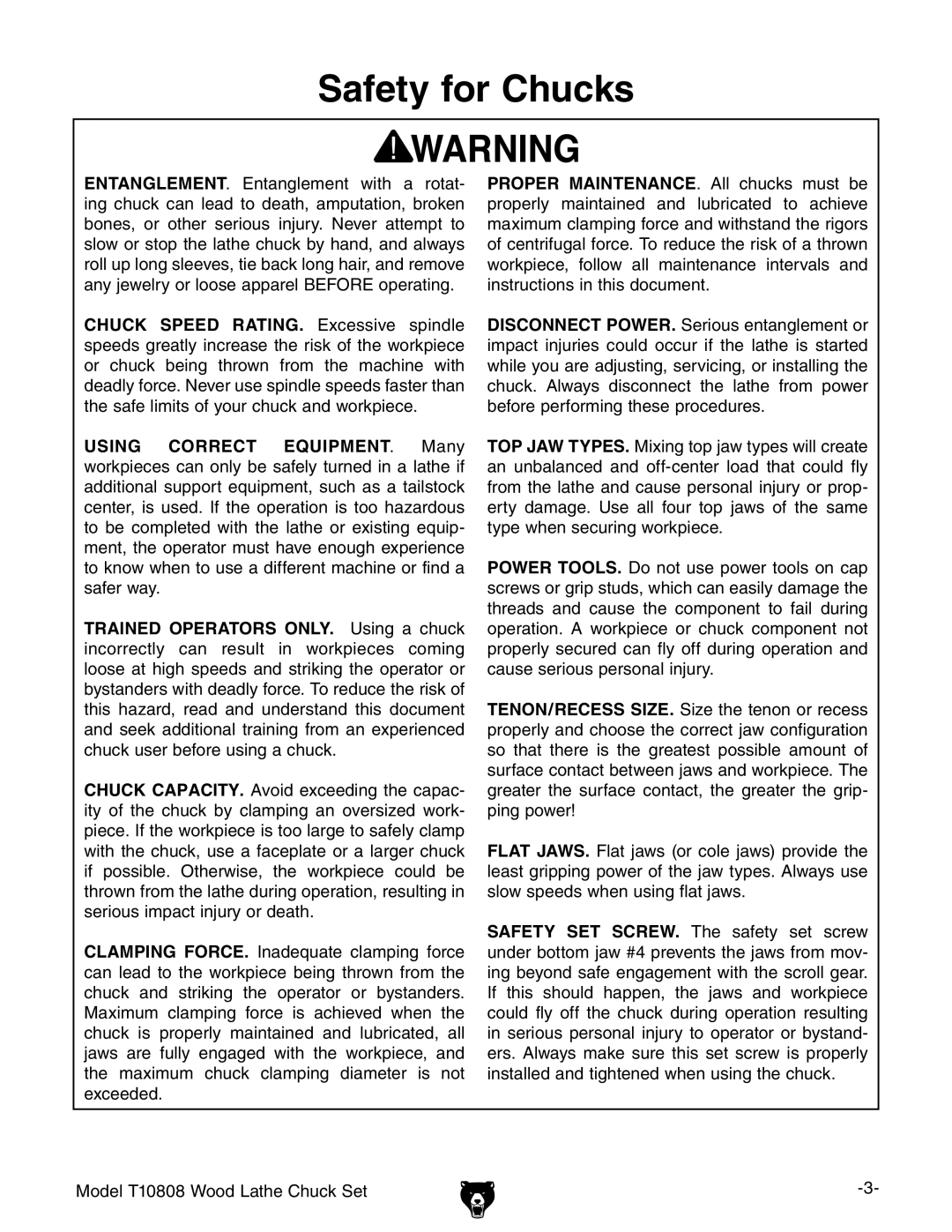
Safety for Chucks
ENTANGLEMENT. Entanglement with a rotat- | PROPER MAINTENANCE. All chucks must be |
ing chuck can lead to death, amputation, broken | properly maintained and lubricated to achieve |
bones, or other serious injury. Never attempt to | maximum clamping force and withstand the rigors |
slow or stop the lathe chuck by hand, and always | of centrifugal force. To reduce the risk of a thrown |
roll up long sleeves, tie back long hair, and remove | workpiece, follow all maintenance intervals and |
any jewelry or loose apparel BEFORE operating. | instructions in this document. |
CHUCK SPEED RATING. Excessive spindle speeds greatly increase the risk of the workpiece or chuck being thrown from the machine with deadly force. Never use spindle speeds faster than the safe limits of your chuck and workpiece.
DISCONNECT POWER. Serious entanglement or impact injuries could occur if the lathe is started while you are adjusting, servicing, or installing the chuck. Always disconnect the lathe from power before performing these procedures.
USING CORRECT EQUIPMENT. Many | TOP JAW TYPES. Mixing top jaw types will create |
workpieces can only be safely turned in a lathe if | an unbalanced and |
additional support equipment, such as a tailstock | from the lathe and cause personal injury or prop- |
center, is used. If the operation is too hazardous | erty damage. Use all four top jaws of the same |
to be completed with the lathe or existing equip- | type when securing workpiece. |
ment, the operator must have enough experience |
|
to know when to use a different machine or find a | POWER TOOLS. Do not use power tools on cap |
safer way. | screws or grip studs, which can easily damage the |
TRAINED OPERATORS ONLY. Using a chuck | threads and cause the component to fail during |
operation. A workpiece or chuck component not | |
incorrectly can result in workpieces coming | properly secured can fly off during operation and |
loose at high speeds and striking the operator or | cause serious personal injury. |
bystanders with deadly force. To reduce the risk of |
|
this hazard, read and understand this document | TENON/RECESS SIZE. Size the tenon or recess |
and seek additional training from an experienced | properly and choose the correct jaw configuration |
chuck user before using a chuck. | so that there is the greatest possible amount of |
CHUCK CAPACITY. Avoid exceeding the capac- | surface contact between jaws and workpiece. The |
greater the surface contact, the greater the grip- | |
ity of the chuck by clamping an oversized work- | ping power! |
piece. If the workpiece is too large to safely clamp |
|
with the chuck, use a faceplate or a larger chuck | FLAT JAWS. Flat jaws (or cole jaws) provide the |
if possible. Otherwise, the workpiece could be | least gripping power of the jaw types. Always use |
thrown from the lathe during operation, resulting in | slow speeds when using flat jaws. |
serious impact injury or death. |
|
CLAMPING FORCE. Inadequate clamping force | SAFETY SET SCREW. The safety set screw |
under bottom jaw #4 prevents the jaws from mov- | |
can lead to the workpiece being thrown from the | ing beyond safe engagement with the scroll gear. |
chuck and striking the operator or bystanders. | If this should happen, the jaws and workpiece |
Maximum clamping force is achieved when the | could fly off the chuck during operation resulting |
chuck is properly maintained and lubricated, all | in serious personal injury to operator or bystand- |
jaws are fully engaged with the workpiece, and | ers. Always make sure this set screw is properly |
the maximum chuck clamping diameter is not | installed and tightened when using the chuck. |
exceeded. |
|
Model T10808 Wood Lathe Chuck Set |
